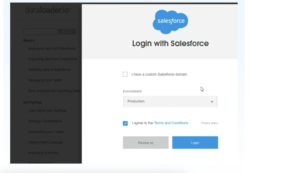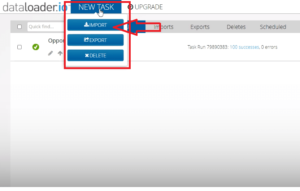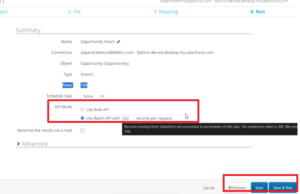In our previous blog post we had discussed about What is Workbench in Salesforce. In these blog post we discuss about Set Batch Size in Data Loader in Salesforce
Contents
Set Batch Size in Data Loader in Salesforce
What is Salesforce Data Loader
Salesforce Data Loader is a powerful data management tool that allows users to import, export, update, or delete a large volume of records in Salesforce. It’s primarily used for batch processing, making it an essential tool for admins and developers who need to handle large datasets quickly and efficiently.
Importance of Using Data Loader for Batch Operations
The main advantage of using the Data Loader is its ability to process large batches of data with minimal manual intervention. It’s ideal for both one-time data migrations and routine data management, reducing the risk of manual entry errors and increasing operational efficiency.
Why is Batch Size Important
The batch size in Data Loader determines how many records are processed at once during an operation. A well-chosen batch size can optimize data processing speed and prevent hitting Salesforce governor limits. On the other hand, an incorrect batch size can lead to performance issues or even data loading errors.
Introduction to Batch Size in Data Loader
What is Batch Size
Batch size refers to the number of records processed in a single transaction by the Data Loader. When handling large volumes of data, breaking them down into smaller batches allows the system to manage resources better and avoid performance bottlenecks.
Impact of Batch Size on Data Processing
The batch size affects not only the speed of data processing but also the overall success rate of the operation. If the batch size is too large, it may overload the system, causing errors like “Request Timed Out” or “API Limit Exceeded.”
Default Batch Size Settings in Data Loader
By default, Salesforce sets the batch size to 200 records for most operations. While this setting works well for smaller datasets, it may need to be adjusted for larger volumes or specific operations like updates or deletes.
Benefits of Configuring the Right Batch Size
Enhanced Data Processing Speed
Optimizing the batch size ensures that Data Loader operates at peak efficiency, reducing the total time required to complete the operation. This is particularly beneficial when working with time-sensitive data loads.
Reduced Chances of Hitting Governor Limits
Salesforce enforces strict governor limits to maintain multi-tenant performance. Properly configured batch sizes help avoid hitting these limits, which can interrupt data operations.
Handling Large Data Volumes Efficiently
When dealing with thousands or millions of records, an appropriate batch size enables Salesforce to process the data without running into memory or API constraints.
Challenges of Using Incorrect Batch Size
Performance Issues with Large Batch Size
If the batch size is set too high, Data Loader may struggle to process the data efficiently, resulting in slow performance or complete operation failure.
Potential API Timeout Errors
Exceeding the optimal batch size can lead to API timeout errors, disrupting the data load process and requiring manual intervention to resolve.
Impact on Salesforce Governor Limits
Large batch sizes can quickly consume API calls or exceed CPU limits, triggering governor limit exceptions and stopping the data load.
Step-by-Step Guide to Set Batch Size in Salesforce Data Loader
Open Salesforce Data Loader

Navigate to setting

Adjust the ‘Batch Size’ field to your desired number of records.

Save your Settings

Verifying the Updated Batch Size
Before starting your data load, it’s a good idea to verify that the batch size has been updated correctly. You can do this by revisiting the Settings tab and checking the Batch Size field to ensure it reflects your new value.
Recommended Batch Size for Different Scenarios
Small Datasets (Under 5,000 Records)
For datasets containing less than 5,000 records, a batch size of 200-500 is generally sufficient. This range offers a balance between speed and reliability, ensuring that each batch is processed quickly without risking timeouts or errors.
Medium Datasets (5,000 to 50,000 Records)
When working with medium-sized datasets, consider setting the batch size between 500 and 1,000. This configuration works well for updates and inserts, allowing for faster processing while maintaining stability.
Large Datasets (Above 50,000 Records)
For very large datasets, a lower batch size may actually be more beneficial. Set the batch size to 200-500 to prevent system overloads and reduce the likelihood of API limit exceptions. It may take longer, but it’s a safer approach for large-scale data operations.
Best Practices for Setting Batch Size in Data Loader
Start with Default Settings
If you’re new to using Salesforce Data Loader, it’s recommended to start with the default batch size settings (200). This provides a stable baseline and allows you to gradually increase the batch size as you gain more experience and understanding of your system’s capacity.
Increase Incrementally for Testing
Always make small, incremental changes when adjusting the batch size. For example, if you’re currently processing 200 records at a time, try increasing it to 300 or 400 and observe the impact. Jumping directly to very large batch sizes can cause unexpected issues.
Monitoring and Adjusting Based on Performance
Regularly monitor the performance of your data operations and adjust the batch size as needed. If you notice slower processing or increased error rates, reduce the batch size and test again until you find the optimal configuration.
Tools and Resources for Optimizing Data Loads
Salesforce Help Documentation
The Salesforce Help Documentation offers in-depth guidance on Data Loader configurations, including batch size settings and optimization tips. It’s a valuable resource for new users and experienced admins alike.
Salesforce Developer Community
Engage with the Salesforce Developer Community to share experiences and get advice on setting the optimal batch size. Many seasoned professionals regularly post solutions to common issues related to data loading.
Third-Party Data Management Tools
If the native Data Loader doesn’t meet your needs, consider exploring third-party tools like Jitterbit, Dataloader.io, or Informatica. These tools often provide advanced data management features and enhanced error handling capabilities.
Common Errors Related to Batch Size and Their Solutions
API Limit Exceeded
This error occurs when the batch size is too large, consuming more API calls than Salesforce allows within a given period. To resolve this, reduce the batch size and try again. You can also check your current API usage through the System Overview in Salesforce.
“Request Timed Out” Error
If your Data Loader operation is timing out, it means the system is struggling to process the batch within the allocated time frame. Lower the batch size and ensure that your network connection is stable.
Unexpected Skipped Records
Skipped records often indicate that some records in the batch do not meet the necessary validation criteria. Verify your data and use a smaller batch size to make it easier to identify and resolve the problematic records.
How to Troubleshoot Batch Size Issues in Salesforce Data Loader
Identifying the Cause of Errors
When encountering errors, it’s crucial to pinpoint the root cause. Check the Salesforce error logs and Data Loader operation logs for specific messages. This will help you identify whether the issue is related to batch size, data quality, or API limits.
Adjusting Batch Size and Retesting
After identifying the issue, adjust the batch size accordingly. If you’re hitting API limits, lower the batch size to reduce the number of API calls. If you’re experiencing validation errors, review your data and test smaller batches until the errors are resolved.
Utilizing Salesforce Logs for Debugging
Salesforce logs can provide detailed insights into the errors encountered during data loads. Use these logs to troubleshoot issues and make data-driven adjustments to your batch size settings.
Understanding Governor Limits in Salesforce
What Are Governor Limits?
Governor limits are restrictions Salesforce places on various operations to ensure optimal performance in a shared multi-tenant environment. These limits include the number of API calls, CPU time, and memory usage allowed per transaction.
How Batch Size Affects Governor Limits
Larger batch sizes consume more resources and are more likely to hit governor limits. By optimizing batch size, you can balance data processing speed with the constraints imposed by Salesforce’s governor limits.
Best Practices to Avoid Hitting Governor Limits
To avoid hitting governor limits, keep batch sizes manageable, especially when dealing with complex operations like updates or deletes. Monitor the usage of your Salesforce org and always keep a buffer to accommodate other processes running in the background.
Conclusion
Setting the right batch size in Salesforce Data Loader is crucial for ensuring efficient and error-free data processing. By understanding how batch size impacts performance and using best practices for different scenarios, you can optimize your data operations and prevent common issues like API timeouts or governor limit errors. Regularly reviewing and adjusting your batch size based on data volume and operation type will help maintain smooth and reliable data loads.
We want to more about Set Batch Size in Data Loader in Salesforce Click Here
FAQs
Can Batch Size Impact Data Loading Speed?
Yes, the batch size directly affects data loading speed. Larger batch sizes can increase speed, but only if the system can handle the load without timing out or hitting governor limits.
What Happens If I Set the Batch Size Too Low?
If the batch size is too low, the operation may take significantly longer to complete. This can be an issue when dealing with large datasets, as the processing time will be extended.
How Do I Determine the Right Batch Size for My Needs?
Start with the default settings and gradually adjust based on the data volume and the performance of your previous operations. Monitoring error logs and system performance will help you identify the ideal batch size.
Can I Change the Batch Size Mid-Operation?
No, once an operation has started, the batch size cannot be modified. You’ll need to stop the current operation, change the batch size, and restart the process.
Are There Any Limits on How Small or Large the Batch Size Can Be?
Yes, Salesforce enforces a minimum and maximum batch size, typically ranging from 1 to 10,000 records. However, setting extremely high values is not recommended due to the risk of performance degradation and errors.
In our next blog post we will discuss about Data Integration Rules in Salesforce








[…] our previous blog post we had discussed about Set Batch Size in Data Loader in Salesforce. In these blog post we discuss about Data Integration Rules in […]